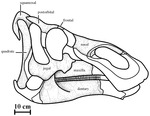| Udurchukan Formation | |
|---|---|
| Stratigraphic range: Maastrichtian ~ | |
| Type | Geological formation |
| Unit of | Tsagayan Group |
| Underlies | Bureya Formation |
| Overlies | Kundur Formation |
| Thickness | 11 metres (40 ft) exposed at Kundur locality |
| Lithology | |
| Primary | Conglomerate, mudstone, diamictite |
| Other | Sandstone |
| Location | |
| Coordinates | 49°30′N 129°30′E / 49.5°N 129.5°E |
| Approximate paleocoordinates | 51°24′N 115°48′E / 51.4°N 115.8°E |
| Region | |
| Country | |
| Extent | Zeya-Bureya Basin |
The Udurchukan Formation is a geological formation located in Amur Region, Far East Russia. Based on palynomorphs such as Wodehouseia spinata, the Udurchukan is considered of Maastrichtian age of the Late Cretaceous, during the Cretaceous Period.
YouTube Encyclopedic
-
1/1Views:3 804
-
Evidencias del Diluvio universal
Transcription
Fossil record
Since Wodehouseia spinata and Aquillapollenites subtilis are known in the Americas only from the Late Maastrichtian, the presence of these palynomorphs in the Udurchukan caused Godefroit to consider the unit and its lambeosaur dominated fauna to be coeval with the Lance Formation and Hell Creek Formation. However, research in the Songliao Basin indicates Wodehouseia spinata is also known from the early (albeit not basal) and middle Maastrichtian of Asia.
The latest view, appearing in the paper on comparative osteology of Edmontosaurus and Shantungosaurus, is that one Udurchukan Formation locality, Kundur, is late−early Maastrichtian; and the other, Blagoveschensk, is early−late Maastrichtian. The Udurchukan Formation now appears somewhat older than the Lance and Hell Creek, albeit not by much.
Dinosaurs
Color key
|
Notes Uncertain or tentative taxa are in small text; |
- Hadrosaurs
| Hadrosaurs reported from the Udurchukan Formation | ||||||
|---|---|---|---|---|---|---|
| Genus | Species | Location | Stratigraphic position | Material | Notes | Images |
| Amurosaurus | A. riabinini | Blagoveschensk | A partial remnants of skull and lower jaw. | A lambeosaurine hadrosaur which was the most common dinosaur in the area, a bonebed containing many specimens was unearthed in 2008.[1] |  | |
| Kerberosaurus | K. manakini | Blagoveschensk | The caudal part of cranium consists of a braincase. | A saurolophine hadrosaur |  | |
| Kundurosaurus | K. nagornyi | Kundur | A partial, disarticulated skull. | A saurolophine hadrosaur; possibly synonymous with Kerberosaurus |  | |
| Olorotitan | O. arharensis | Kundur | A nearly complete skeleton. | A hadrosaur |  | |
- Sauropods
| Sauropods reported from the Udurchukan Formation | ||||||
|---|---|---|---|---|---|---|
| Genus | Species | Location | Stratigraphic position | Material | Notes | Images |
| Arkharavia[2] | A. heterocoelica | Kundur | Upper | A single tooth and a proximal tail vertebrae, although some remains probably belong to a hadrosaurid. | A Somphospondyli sauropod.[3] | |
Other fossils
- Vertebrates
- Amuremys planicostata
- Albertosaurinae indet.
- Tyrannosaurinae indet.
- Richardoestesia sp. (morph 1)
- Richardoestesia sp. (morph 2)
- Shamosuchus sp.
- Troodon sp.
- Dromaeosaurinae indet.
- Dromaeosauridae indet.
- cf. Saurornitholestes sp.
- Cimolodonta indet.
- Crocodylia indet.
- Hadrosaurinae indet.
- Lindholmemydidae indet.
- Nodosauridae indet.
- Opisthocoelicaudiinae indet.
- Ornithomimidae indet.[4]
- Testudines indet.
- Titanosauria indet.
- Theropoda indet.
- Trionychidae indet.
- Insects
- Mesosigara kryshtofovichi
- Flora
- Cupressinoxylon sp.
See also
References
- ^ Lauters, Pascaline; Bolotsky, Yuri L.; Van Itterbeeck, Jimmy; Godefroit, Pascal (March 1, 2008). "Taphonomy and Age Profile of a Latest Cretaceous Dinosaur Bone Bed in Far Eastern Russia". PALAIOS. 23 (3). SEPM Society for Sedimentary Geology: 153–162. Retrieved 1 May 2021.
- ^ Alifanov, Vladimir & Bolotsky, Yu. (2010). Arkharavia heterocoelica gen. et sp. nov., a new sauropod dinosaur from the Upper Cretaceous of the Far East of Russia. Paleontological Journal. 44. 84-91. 10.1134/S0031030110010119.
- ^ Mannion, Philip D.; Upchurch, Paul; Barnes, Rosie N.; Mateus, Octávio (2013). "Osteology of the Late Jurassic Portuguese sauropod dinosaur Lusotitan atalaiensis (Macronaria) and the evolutionary history of basal titanosauriforms". Zoological Journal of the Linnean Society. 168: 98. doi:10.1111/zoj.12029.
- ^ Averianov, Alexander; Skutschas, Pavel; Bolotsky, Yuriy; Bolotsky, Ivan (2023-12-31). "First find of an ornithomimid theropod dinosaur in the Upper Cretaceous of the Russian Far East". Biological Communications. 68 (4). doi:10.21638/spbu03.2023.405. ISSN 2587-5779.
Bibliography
- Y. A. Popov. 1971. Historical development of the infraorder Nepomorpha (Heteroptera). Akademiya Nauk SSSR, Trudy Paleontologicheskogo Instituta 129:1-228

